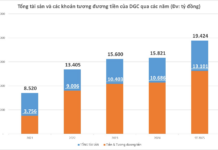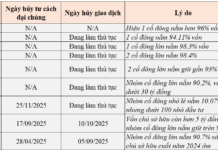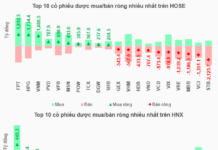Economic Perspective on Debt
In economics, debt is recorded in two main forms: “Accounts Receivable” for sellers/service providers and “Accounts Payable” for buyers. The value and measurability of debt play an important role in assessing the financial health of a business.
The accounts receivable turnover ratio (revenue/Accounts Receivable) is an important financial ratio that evaluates the ability to recover revenue. The Number of Days of Accounts Receivable (365/Accounts Receivable Turnover) indicates the time required to recover revenue.

In practice, debt trading is becoming very common in the market, especially in relation to Credit Contracts of commercial banks. Illustrated: DNCC
|
In practice, some companies report large revenues in their accounting records, but cash flows account for a small proportion, thus affecting liquidity. For public companies, the “exaggeration” of financial capabilities through revenue figures and the “reduction” of cash flow information from debt recovery to maintain stock prices is not uncommon.
Therefore, examining information and indicators related to debt has a significant impact on the business strategies of managers and their decisions to “invest in” businesses for investors.
Debt is the obligation of the debtor to repay assets to the creditor, as stipulated in contracts or arising from rights and other obligations under the law. Debt is usually defined based on currency.
According to the provisions of Article 280 of the 2015 Civil Code, monetary obligations must be fully and timely fulfilled, at the agreed place and method. At the same time, the monetary obligation includes interest on the principal debt, except for other agreements.
In addition, debt can also be seen as a type of asset (property right), and the owner of this asset can transfer it to a third party through a Debt Purchase Agreement when certain conditions are met. Through this transaction, the debt buyer becomes the legal owner of this asset, and the debtor must fulfill the obligation to pay the debt buyer.
In practice, debt trading is becoming very common in the market, especially in relation to Credit Contracts of commercial banks.
Effective Use, Management, and Recovery of Debt
The effective use and management of debt is a particularly important and sensitive issue. Effective use, management, and recovery of debt help businesses ensure cash flow and profit for distribution. This is also a key factor in attracting and maintaining investor participation and contributing to the long-term development of the business. Therefore, to optimize debt management, each business needs to consider some optimal options.
First, an important part of debt recovery is effective management from the beginning. To meet this requirement, every creditor needs to pay attention to verifying information and transaction history of customers; signing contracts with clear terms of payment and settlement. From there, the debt management department constantly monitors and updates information regularly with customers.
In cases of mutual agreement, the determination of debt and payment schedule needs to be clearly recorded in written form with the confirmation of authorized personnel from each party.
 In practice, debt trading is becoming very common in the market, especially in relation to Credit Contracts of commercial banks. Illustrated: DNCC |
Debt reconciliation is also a task of independent auditing firms when auditing financial statements, especially for public companies. These records are often expressed in the form of: Debt confirmation letters, debt reconciliation statements… In some special relationships such as construction, the agreed results of debt are also expressed in the form of completion settlement records for use.
Each business should also establish its own internal debt management plan and regulations. In this plan, for each customer with separate transaction histories, the business will limit the amount and value of debt to a certain level to alert risks. This is an important basis for parties to consider the ability to continue transactions and plan the recovery path for existing debt appropriately.
In addition to the debt management plan, the use of guarantees is also an effective way to deal with Accounts Receivable. A guarantee is when the guarantor (usually a bank) commits to the beneficiary (creditor) to fulfill the obligations on behalf of the guarantor (debtor) if when the obligation is due, the beneficiary does not fulfill or fulfill the obligation.
Guarantees are usually carried out in forms such as Contractual Guarantees, Payment Guarantees, Temporary Advance Guarantees… The creditor needs to note that guarantees are often limited for a certain period called the guarantee period. In cases where the repayment of debt obligations extends beyond the guarantee period, the request for guarantee extension needs to be set.
In some cases, the guarantee clause is considered one of the prerequisites for parties to decide to participate in the transaction.
The third solution for optimal handling of debt is through agreement on debt resolution. In any commercial relationship, giving each other opportunities to meet, express opinions, and agree on a resolution when conflicts arise is always a necessary choice before participating in litigation at arbitration authorities. There are many ways to implement debt resolution agreements, such as actively organizing meetings to agree, mediating at commercial mediation centers or mediation at the Court before filing a lawsuit.
If the parties cannot reach an agreement, the creditor initiating legal proceedings against the debtor at the competent arbitration authority to recover the debt is the last resort. Accordingly, the creditor must fulfils all procedures from filing the lawsuit, participating in meetings, and hearings at the first-instance, appellate, and even cassation stages as prescribed by law.
The parties need to gather documents and evidence and make arguments to prove the debt to protect their respective interests. This is considered the most coercive option and also a time-consuming and labor-intensive choice, so parties need to consider before use.
The request to initiate bankruptcy proceedings is a viable option to recover debt when the debtor is unable to repay. It should be noted that the assets of the enterprise being bankrupt will be divided in order and in commercial transactions, creditors often have the last priority. This can put them at a disadvantage as the debtor’s assets have been used to pay for the earlier groups. Therefore, before deciding to use this option, the creditor needs to carefully consider the recovery potential, and compile information about the debtor’s assets to ensure the most effective and appropriate recovery process.
Debt recovery is a sensitive and complex process that needs to be considered from many perspectives. To “prevent rather than cure,” business owners need to consider constructing effective strategies and debt management within their organizations. When forced to recover, agreement on conflict resolution combined with legal dispute resolution options should be applied flexibly to ensure the legitimate rights and interests of the parties.
Xuân Đạt – Ngọc Công (Pros Legal Limited Liability Law Company, Hochiminh City)





































